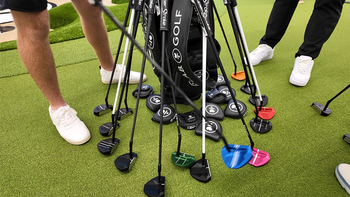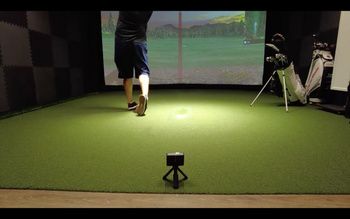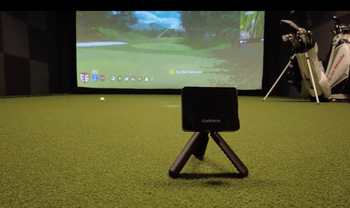You'll need a minimum of 10 feet wide, 14 feet deep, and 8 feet high for a basic golf simulator setup, though larger dimensions are ideal for optimal performance and comfort. The height allows for unrestricted swings, while the width prevents wall collisions. Depth is essential for backswing space and ball flight. Launch monitors, whether radar or camera-based, require additional factors. Garages, basements, or dedicated rooms can work well, but remember to factor in ventilation and power sources. Adequate space improves swing mechanics, boosts simulation realism, and increases overall enjoyment. For a truly immersive experience, you might want to think about going beyond the bare minimum requirements.
Minimum Room Dimensions
Setting up a golf simulator at home requires careful consideration of room dimensions. Most golfers need a ceiling height of 9 to 10 feet for full swings without clubhead clearance issues. Shorter players might manage with 8 feet.
Width-wise, you'll want 10-12 feet on each side of the tee for free swinging. Depth is critical: 13 feet is the bare minimum, but 18 feet or more is preferable. Don't forget to leave 1-2 feet between your hitting net and walls to protect against errant shots.
The ideal setup measures about 9 feet high, 10 feet wide, and 14 feet deep. This configuration creates a compact indoor golf space for year-round practice, regardless of weather conditions.
These dimensions are based on empirical data from golf equipment manufacturers and professional simulator installers. Companies like SkyTrak and TruGolf have conducted extensive research to determine optimal room sizes for various player heights and swing types.
Interestingly, some golfers have found creative solutions for smaller spaces. For example, lefty Phil Mickelson famously practiced in his garage by hitting balls into a net just a few feet away. While not ideal, it shows that dedication can overcome space limitations.
Ceiling Height Requirements
Ceiling height is a big deal for golf simulators. You need at least 8 feet, but 9-10 feet is way better. This extra space lets you swing freely without smacking the ceiling.
Even if you're short, don't skimp on height. Your tall buddies will appreciate the room when they come over to play. Plus, you'll want space above the hitting area for the net and to protect your ceiling. Leave about 1.5 feet of clearance above the impact screen.
This buffer isn't just for safety. It improves air flow and gives you more options for lighting. In the world of golf simulators, bigger is better when it comes to ceiling height. Your game will improve, and your ceiling will stay dent-free.
Remember, pros like Tiger Woods and Rory McIlroy use high-tech simulators with plenty of headroom. They know the value of space for a full swing.
Studies from the PGA Tour have shown that restricted swing paths can lead to compensations in technique, potentially hurting your game in the long run.
Width Considerations
When it comes to golf simulator setups, width matters big time. You gotta have enough room to swing freely without worrying about smacking into walls or other stuff. Most pros recommend at least 10 feet wide, which works for different body types and swing styles. If you want a centered tee area, shoot for 14 feet. This extra space makes for a more realistic and fun experience.
Don't skimp on buffer space! Leave about 1.5 feet on each side of where you're hitting from. This is key for safety and comfort, especially if you've got both lefties and righties using the setup.
Working with a tight space? An adjustable tee spot can be a game-changer, but remember, 10 feet is still the bare minimum for a decent setup.
By nailing the width requirements, you'll create a simulator that's not just functional, but a blast to use. Whether you're fine-tuning your swing or playing a virtual round with buddies, you'll be glad you put in the thought upfront.
Golf Digest and PGA professionals often stress the importance of proper simulator dimensions for optimal practice and enjoyment.
Length and Depth Needs

Let's talk golf simulator depth. You need space to swing freely and play safely. Aim for at least 14 feet, but 18 feet is better. This gives you room to place the tee and creates a buffer behind the impact screen.
Speaking of screens, leave 2 feet behind it. Your walls will thank you when those wild shots come. For the area behind the tee, 7-9 feet works for most golfers. This lets you nail that backswing without knocking stuff over.
If you're tight on space, 16 feet can still work well. Remember, everyone's swing is different. Think about your own style when setting up.
PGA Tour pro Bryson DeChambeau, known for his "science of swing" approach, might need more room due to his long backswing. On the flip side, a compact swinger like Collin Morikawa could manage with less space.
The key is to create a comfortable, safe environment that mimics real play. With the right setup, you'll be crushing drives and sinking putts in your own home.
Just don't forget to invite your golf buddies over for some friendly competition!
Launch Monitor Space Factors
Launch monitors are key to any golf simulator setup, but they need specific space to work right. Different types have different needs. Radar-based ones like Mevo Plus or Garmin Approach R10 want at least 8 feet of ball flight space and need to sit 7-9 feet behind you.
Camera-based monitors like Skytrak and GCQuad are less picky, only needing a few feet of ball flight.
Your swing needs room too. You'll want 7-12 feet behind the tee, depending on your monitor type. This space keeps you safe and lets you swing freely. Radar systems need more distance between the ball and screen to get good data. It's like giving your shot some runway before takeoff.
Knowing these space needs is crucial for a good setup. Make sure you've got the right room for your monitor before you start hitting. Your virtual golf game will be better for it.
Some golfers overlook these details and end up with a cramped setup. That can lead to poor data, which messes up your practice.
On the flip side, too much space can be wasteful. The sweet spot is just enough room for your monitor to work well and for you to swing comfortably.
Remember, each brand of launch monitor might've slightly different needs. Always check the manufacturer's specs before you set up.
And if you're tight on space, you might want to look into portable options that can be set up and taken down as needed.
Simulator Type Impact

Choosing a golf simulator isn't just about brand preference; the type you pick can make or break your setup. Radar-based systems like the Mevo Plus are space hogs. They need at least 8 feet for ball flight and 7-9 feet behind you to work their magic. It's like they've got a big appetite for square footage.
Camera-based systems, think Skytrak, are more compact. They're cool with just a few feet of ball flight, making them a solid choice for smaller rooms. If you're working with limited space, these systems give you more wiggle room for setup.
The impact screen isn't just for show, folks. It's a key player in your simulator game. Radar systems often require extra clearance behind the screen, usually 2 feet or more. This keeps your balls from turning into unexpected wall art. Knowing these nitty-gritty details is crucial for planning your space and getting the most out of your indoor golf experience.
Before you start swinging, make sure you've sized up your space and picked the right simulator type. It's not just about fitting the gear in; it's about creating a setup that lets you play your best game.
Optimizing Available Space
Maximizing limited space for your golf simulator? No sweat. Aim for a room at least 9 feet high, 10 feet wide, and 14 feet deep. This gives you enough room to swing without smacking walls or ceilings.
Think beyond the swing area. Leave 1-2 feet behind the impact screen to protect your walls and let the net do its job. For radar-based launch monitors, position them 7-9 feet behind you for accurate readings.
Got extra space? Go for 12-14 feet wide. This works for both right and left-handed golfers. More depth and width? Perfect for setting up a projector or adding a comfy chair for breaks.
These dimensions are based on industry standards and recommendations from golf simulator experts like Foresight Sports and TruGolf. They've tested countless setups to find the sweet spot between comfort and functionality.
Here's a real-world example: PGA Tour pro Rickie Fowler has a custom simulator in his garage. It's 15 feet wide, 20 feet deep, and 10 feet high - slightly larger than the minimum, but it shows how pros value space in their setups.
Conclusion
You've now got the blueprint for your golf simulator space, but remember, one size doesn't fit all! Like a well-tailored golf glove, your setup should mold to your unique needs and constraints. Whether you're working with a spacious man cave or squeezing into a cozy corner, there's likely a solution that'll have you teeing off in no time. With some creative thinking and careful planning, you'll be swinging away in your personal golf paradise before you know it.





